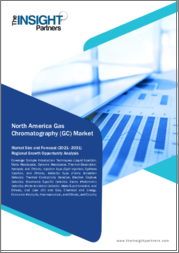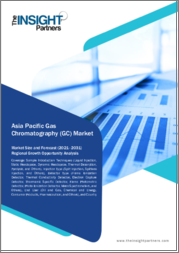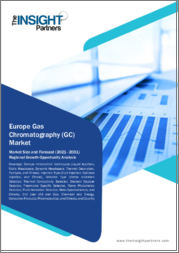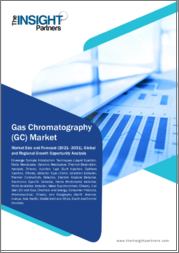
|
시장보고서
상품코드
1580935
염광광도계 시장 : 유형, 용도, 최종사용자별 - 세계 예측(2025-2030년)Flame Photometric Detector Market by Type (Dual Wavelength Photometric Detector, Single Wavelength Photometric Detector), Application (Agricultural Research, Clinical Laboratories, Environmental Monitoring), End-User - Global Forecast 2025-2030 |
||||||
염광광도계 시장은 2023년 7억 4,319만 달러로 평가되고 2024년에는 7억 8,927만 달러에 달할 것으로 예상되며, 연평균 6.77% 성장하여 2030년에는 11억 7,597만 달러에 달할 것으로 예상됩니다.
염광광도계(FPD)는 주로 석유화학, 환경 모니터링 및 식품 안전 산업에서 사용되는 황, 인 및 기타 특정 원소를 감지하여 가스 크로마토그래피에서 중요한 역할을 합니다. 그 핵심 기능은 화염에서 분석물을 연소시켜 원소의 특징적인 발광을 얻어 복잡한 매트릭스에서 미량 원소를 검출하고 정량하는 데 도움이되며, FPD의 필요성은 유해 화합물을 감지하고 규제 준수를 촉진하며 제품 안전을 보장하기 위해 높은 특이성과 감도가 필요한 분야에서 강조되고 있습니다. 그 적용 범위는 연료의 황 화합물을 식별하는 석유화학 분석, 오염 물질 수준을 모니터링하는 환경 과학, 오염 기준 준수를 보장하는 식품 안전 등 다양합니다. 최종 사용 산업에는 석유화학, 환경 기관, 제약, 식음료 부문이 포함됩니다. 시장 인사이트에 따르면, 환경 규제의 급증과 정제된 고순도 제품에 대한 수요 증가는 FPD의 성장을 크게 촉진하고 있습니다. 새로운 비즈니스 기회는 센서 기술의 발전과 바이오연료 분석, 제약 연구와 같은 새로운 애플리케이션의 확대에 있습니다. 이러한 기회를 활용하기 위해서는 검출기의 감도를 높이고 검출 한계를 낮추기 위한 연구개발에 투자하는 것이 바람직합니다. 그러나 시장에서는 더 높은 해상도와 더 종합적인 분석 능력을 제공하는 질량 분석과 같은 대체 검출 기술과의 경쟁이라는 과제에 직면해 있습니다. 기술적 복잡성과 숙련된 인력의 필요성이 보급을 더욱 제한하고 있습니다. 시장의 혁신적 개척에는 휴대용 및 현장 사용에 적합한 작고 사용하기 쉬운 기기의 개발이 포함되며, 이는 고급 실험실 외의 장소에서 일반화될 가능성이 있습니다. 시장의 특성은 고도로 기술적이며, 규제 기준과 정확성과 효율성에 대한 업계의 요구로 인해 끊임없는 혁신이 이루어지고 있으며, FPD를 새로운 사물인터넷(IoT) 기술과 통합하기 위해 다양한 분야의 협업을 도입하는 것은 향후 발전과 비즈니스 성장을 촉진할 수 있습니다. 성장을 촉진할 수 있습니다.
| 주요 시장 통계 | |
|---|---|
| 기준 연도[2023] | 7억 4,319만 달러 |
| 예측 연도[2024] | 7억 8,927만 달러 |
| 예측 연도[2030] | 11억 7,597만 달러 |
| CAGR(%) | 6.77% |
시장 역학 : 빠르게 진화하는 염광광도계 시장의 주요 시장 인사이트 공개
염광광도계 시장은 수요와 공급의 역동적인 상호작용에 의해 변화하고 있습니다. 이러한 시장 역학의 진화를 이해함으로써 기업은 정보에 입각한 투자 결정, 전략적 의사결정, 새로운 비즈니스 기회를 포착할 수 있습니다. 이러한 트렌드를 종합적으로 파악함으로써 기업은 정치적, 지리적, 기술적, 사회적, 경제적 영역 전반에 걸친 다양한 위험을 줄일 수 있으며, 소비자 행동과 그것이 제조 비용 및 구매 동향에 미치는 영향을 보다 명확하게 이해할 수 있습니다.
- 시장 촉진요인
- 유황 화합물 및 인 화합물의 정확한 검출이 필요한 제약 및 생명공학 분야의 확대
- 산업 시설의 엄격한 배출 규제로 인해 첨단 감지 시스템의 사용이 강화되고 있습니다.
- 화학 분석 및 환경 검사에 대한 R&D 투자 급증
- 현장 및 현장 분석 애플리케이션을 위한 휴대용 화염 광도 검출기 채택 증가
- 시장 억제요인
- 특수 감지 장비를 조작하고 유지보수할 숙련된 전문가 부족
- 기술의 발전과 대체 분석 기술과의 경쟁으로 인한 시장 수요 감소
- 시장 기회
- 유황 화합물 검출을 위한 환경 모니터링에서 화염 광도 검출기 적용 확대
- 산업 공정 제어에서 감도와 선택성 향상을 위한 염광광도계 기술 발전
- 다양한 분석 요구에 대응하는 맞춤형 염광광도계 솔루션으로 신흥 시장 개척
- 시장 과제
- 높은 유지보수 및 운영 비용이 전체 시장 성장에 영향을 미치는 염광광도계의 문제점
- 염광광도계 제조업체가 직면한 엄격한 규제 기준 및 규정 준수 요건 준수에 대한 도전 과제
Porter's Five Forces : 염광광도계 시장을 탐색하는 전략적 도구
Porter's Five Forces 프레임워크는 염광광도계 시장의 경쟁 상황을 이해하는 중요한 도구입니다. Porter's Five Forces 프레임워크는 기업의 경쟁력을 평가하고 전략적 기회를 모색할 수 있는 명확한 방법을 제공합니다. 이 프레임워크는 기업이 시장 내 세력도를 평가하고 신규 사업의 수익성을 판단하는 데 도움이 됩니다. 이러한 인사이트를 통해 기업은 강점을 활용하고, 약점을 해결하고, 잠재적인 도전을 피하고, 보다 강력한 시장 포지셔닝을 확보할 수 있습니다.
PESTLE 분석 : 염광광도계 시장에서의 외부 영향 파악
외부 거시 환경 요인은 염광광도계 시장의 성과 역학을 형성하는 데 매우 중요한 역할을 합니다. 정치적, 경제적, 사회적, 기술적, 법적, 환경적 요인에 대한 분석은 이러한 영향을 탐색하는 데 필요한 정보를 제공하며, PESTLE 요인을 조사함으로써 기업은 잠재적 위험과 기회를 더 잘 이해할 수 있습니다. 이러한 분석을 통해 기업은 규제, 소비자 선호도, 경제 동향의 변화를 예측하고 선제적이고 능동적인 의사결정을 내릴 준비를 할 수 있습니다.
시장 점유율 분석 : 염광광도계 시장에서의 경쟁 상황 파악
염광광도계 시장의 상세한 시장 점유율 분석을 통해 벤더의 성과를 종합적으로 평가할 수 있습니다. 기업은 수익, 고객 기반, 성장률과 같은 주요 지표를 비교하여 경쟁적 위치를 파악할 수 있습니다. 이 분석은 시장의 집중화, 단편화, 통합의 추세를 파악할 수 있으며, 공급업체는 치열한 경쟁 속에서 자신의 입지를 강화할 수 있는 전략적 의사결정을 내리는 데 필요한 인사이트를 얻을 수 있습니다.
FPNV 포지셔닝 매트릭스 : 염광광도계 시장에서 벤더의 성능 평가
FPNV 포지셔닝 매트릭스는 염광광도계 시장에서 벤더를 평가하는 중요한 도구입니다. 이 매트릭스를 통해 비즈니스 조직은 벤더의 비즈니스 전략과 제품 만족도를 기반으로 평가하여 목표에 부합하는 정보에 입각한 의사결정을 내릴 수 있으며, 4개의 사분면으로 벤더를 명확하고 정확하게 세분화하여 전략 목표에 가장 적합한 파트너와 솔루션을 식별할 수 있습니다. 전략 목표에 가장 적합한 파트너와 솔루션을 식별할 수 있습니다.
전략 분석 및 추천 : 염광광도계 시장에서의 성공을 위한 전략 분석 및 추천
염광광도계 시장 전략 분석은 세계 시장에서 입지를 강화하고자 하는 기업에게 필수적입니다. 주요 자원, 역량 및 성과 지표를 검토함으로써 기업은 성장 기회를 식별하고 개선할 수 있습니다. 이러한 접근 방식을 통해 경쟁 환경의 도전을 극복하고 새로운 비즈니스 기회를 활용하여 장기적인 성공을 거둘 수 있도록 준비할 수 있습니다.
이 보고서는 주요 관심 분야를 포괄하는 시장에 대한 종합적인 분석을 제공합니다.
1. 시장 침투도: 현재 시장 환경의 상세한 검토, 주요 기업의 광범위한 데이터, 시장 도달 범위 및 전반적인 영향력 평가.
2. 시장 개척도: 신흥 시장에서의 성장 기회를 파악하고, 기존 분야의 확장 가능성을 평가하며, 미래 성장을 위한 전략적 로드맵을 제공합니다.
3. 시장 다각화: 최근 제품 출시, 미개척 지역, 업계의 주요 발전, 시장을 형성하는 전략적 투자를 분석합니다.
4. 경쟁 평가 및 정보: 경쟁 상황을 철저히 분석하여 시장 점유율, 사업 전략, 제품 포트폴리오, 인증, 규제 당국의 승인, 특허 동향, 주요 기업의 기술 발전 등을 검토합니다.
5. 제품 개발 및 혁신: 향후 시장 성장을 촉진할 것으로 예상되는 첨단 기술, 연구 개발 활동 및 제품 혁신을 강조합니다.
이해관계자들이 충분한 정보를 바탕으로 의사결정을 내릴 수 있도록 다음과 같은 중요한 질문에 대한 답변도 제공합니다.
1. 현재 시장 규모와 향후 성장 전망은?
2. 최고의 투자 기회를 제공하는 제품, 부문, 지역은 어디인가?
3. 시장을 형성하는 주요 기술 동향과 규제의 영향은?
4. 주요 벤더의 시장 점유율과 경쟁 포지션은?
5. 벤더의 시장 진입 및 철수 전략의 원동력이 되는 수익원과 전략적 기회는 무엇인가?
목차
제1장 서문
제2장 조사 방법
제3장 주요 요약
제4장 시장 개요
제5장 시장 인사이트
- 시장 역학
- 성장 촉진요인
- 성장 억제요인
- 기회
- 과제
- 시장 세분화 분석
- Porter's Five Forces 분석
- PESTEL 분석
- 정치
- 경제
- 사회
- 기술
- 법률
- 환경
제6장 염광광도계 시장 : 유형별
- 2 파장 광도 검출기
- 단일 파장 광도 검출기
제7장 염광광도계 시장 : 용도별
- 농업 조사
- 임상 검사실
- 환경 모니터링
- 식품 및 음료 검사
- 석유화학 분석
- 의약품 분석
제8장 염광광도계 시장 : 최종사용자별
- 화학·석유화학
- 식품 및 음료
- 헬스케어·의약품
- 조사실
제9장 아메리카의 염광광도계 시장
- 아르헨티나
- 브라질
- 캐나다
- 멕시코
- 미국
제10장 아시아태평양의 염광광도계 시장
- 호주
- 중국
- 인도
- 인도네시아
- 일본
- 말레이시아
- 필리핀
- 싱가포르
- 한국
- 대만
- 태국
- 베트남
제11장 유럽, 중동 및 아프리카의 염광광도계 시장
- 덴마크
- 이집트
- 핀란드
- 프랑스
- 독일
- 이스라엘
- 이탈리아
- 네덜란드
- 나이지리아
- 노르웨이
- 폴란드
- 카타르
- 러시아
- 사우디아라비아
- 남아프리카공화국
- 스페인
- 스웨덴
- 스위스
- 터키
- 아랍에미리트
- 영국
제12장 경쟁 상황
- 시장 점유율 분석, 2023년
- FPNV 포지셔닝 매트릭스, 2023년
- 경쟁 시나리오 분석
- 전략 분석과 제안
기업 리스트
- Agilent Technologies
- AMETEK Process Instruments
- Buck Scientific
- Chromatotec Group
- Elementar Analysensysteme
- GOW-MAC Instrument Co.
- Hermann Sewerin GmbH
- Hitachi High-Technologies
- Hove Lab
- JASCO Corporation
- LabTech S.r.l.
- LECO Corporation
- Merck KGaA
- OI Analytical
- PerkinElmer
- Restek Corporation
- Shimadzu Corporation
- SRI Instruments
- Teledyne Technologies
- Thermo Fisher Scientific
The Flame Photometric Detector Market was valued at USD 743.19 million in 2023, expected to reach USD 789.27 million in 2024, and is projected to grow at a CAGR of 6.77%, to USD 1,175.97 million by 2030.
The Flame Photometric Detector (FPD) plays a crucial role in gas chromatography by detecting sulfur, phosphorus, and other specific elements, primarily used in petrochemical, environmental monitoring, and food safety industries. Its core function revolves around combusting analytes in a flame, yielding light emissions characteristic of the element, and is instrumental in detecting and quantifying trace elements within complex matrices. The necessity of FPDs is underscored in sectors requiring high specificity and sensitivity to detect harmful compounds, facilitate regulatory compliance, and ensure product safety. The application scope stretches across petrochemical analysis for identifying sulfur compounds in fuels, environmental science for monitoring pollutant levels, and food safety for ensuring compliance with contamination standards. End-use industries predominantly include petrochemical, environmental agencies, pharmaceuticals, and food & beverage sectors. Market insights reveal that burgeoning environmental regulations and increasing demand for refined and high-purity products significantly propel the growth of FPDs. Emerging opportunities lie in advancing sensor technologies and expanding into novel applications such as biofuel analysis and pharmaceutical research. To leverage these opportunities, investments in R&D for enhancing detector sensitivity and reducing detection limits are recommended. However, the market faces challenges like high competition from alternative detection technologies like mass spectrometry, which offer higher resolution and more comprehensive analysis capabilities. Technical complexities and the need for skilled personnel further limit widespread adoption. The market's innovative frontiers include developing compact, user-friendly devices suitable for portable or field applications, potentially democratizing its use beyond advanced laboratories. The nature of the market is highly technical, with a continuous push for innovation driven by regulatory standards and industry demands for accuracy and efficiency. Embracing cross-disciplinary collaboration to integrate FPDs with emerging Internet of Things (IoT) technologies could drive future advancements and business growth.
| KEY MARKET STATISTICS | |
|---|---|
| Base Year [2023] | USD 743.19 million |
| Estimated Year [2024] | USD 789.27 million |
| Forecast Year [2030] | USD 1,175.97 million |
| CAGR (%) | 6.77% |
Market Dynamics: Unveiling Key Market Insights in the Rapidly Evolving Flame Photometric Detector Market
The Flame Photometric Detector Market is undergoing transformative changes driven by a dynamic interplay of supply and demand factors. Understanding these evolving market dynamics prepares business organizations to make informed investment decisions, refine strategic decisions, and seize new opportunities. By gaining a comprehensive view of these trends, business organizations can mitigate various risks across political, geographic, technical, social, and economic domains while also gaining a clearer understanding of consumer behavior and its impact on manufacturing costs and purchasing trends.
- Market Drivers
- Expanding pharmaceutical and biotechnology sectors demanding precise detection of sulfur and phosphorous compounds
- Stringent regulations for emission control in industrial facilities enhancing the use of advanced detection systems
- Surging investments in research and development in chemical analysis and environmental testing
- Increasing adoption of portable flame photometric detectors for on-site and field analysis applications
- Market Restraints
- Limited availability of skilled professionals to operate and maintain specialized detection instruments
- Technological advancements and competition from alternative analytical techniques reducing market demand
- Market Opportunities
- Expanding the application of flame photometric detectors in environmental monitoring for sulfur compound detection
- Advancing flame photometric detector technologies for enhanced sensitivity and selectivity in industrial process control
- Targeting emerging markets with customizable flame photometric detector solutions for diverse analytical needs
- Market Challenges
- Challenges related to the high cost of flame photometric detector maintenance and operation affecting overall market growth
- Challenges faced by flame photometric detector manufacturers in adhering to stringent regulatory standards and compliance requirements
Porter's Five Forces: A Strategic Tool for Navigating the Flame Photometric Detector Market
Porter's five forces framework is a critical tool for understanding the competitive landscape of the Flame Photometric Detector Market. It offers business organizations with a clear methodology for evaluating their competitive positioning and exploring strategic opportunities. This framework helps businesses assess the power dynamics within the market and determine the profitability of new ventures. With these insights, business organizations can leverage their strengths, address weaknesses, and avoid potential challenges, ensuring a more resilient market positioning.
PESTLE Analysis: Navigating External Influences in the Flame Photometric Detector Market
External macro-environmental factors play a pivotal role in shaping the performance dynamics of the Flame Photometric Detector Market. Political, Economic, Social, Technological, Legal, and Environmental factors analysis provides the necessary information to navigate these influences. By examining PESTLE factors, businesses can better understand potential risks and opportunities. This analysis enables business organizations to anticipate changes in regulations, consumer preferences, and economic trends, ensuring they are prepared to make proactive, forward-thinking decisions.
Market Share Analysis: Understanding the Competitive Landscape in the Flame Photometric Detector Market
A detailed market share analysis in the Flame Photometric Detector Market provides a comprehensive assessment of vendors' performance. Companies can identify their competitive positioning by comparing key metrics, including revenue, customer base, and growth rates. This analysis highlights market concentration, fragmentation, and trends in consolidation, offering vendors the insights required to make strategic decisions that enhance their position in an increasingly competitive landscape.
FPNV Positioning Matrix: Evaluating Vendors' Performance in the Flame Photometric Detector Market
The Forefront, Pathfinder, Niche, Vital (FPNV) Positioning Matrix is a critical tool for evaluating vendors within the Flame Photometric Detector Market. This matrix enables business organizations to make well-informed decisions that align with their goals by assessing vendors based on their business strategy and product satisfaction. The four quadrants provide a clear and precise segmentation of vendors, helping users identify the right partners and solutions that best fit their strategic objectives.
Strategy Analysis & Recommendation: Charting a Path to Success in the Flame Photometric Detector Market
A strategic analysis of the Flame Photometric Detector Market is essential for businesses looking to strengthen their global market presence. By reviewing key resources, capabilities, and performance indicators, business organizations can identify growth opportunities and work toward improvement. This approach helps businesses navigate challenges in the competitive landscape and ensures they are well-positioned to capitalize on newer opportunities and drive long-term success.
Key Company Profiles
The report delves into recent significant developments in the Flame Photometric Detector Market, highlighting leading vendors and their innovative profiles. These include Agilent Technologies, AMETEK Process Instruments, Buck Scientific, Chromatotec Group, Elementar Analysensysteme, GOW-MAC Instrument Co., Hermann Sewerin GmbH, Hitachi High-Technologies, Hove Lab, JASCO Corporation, LabTech S.r.l., LECO Corporation, Merck KGaA, OI Analytical, PerkinElmer, Restek Corporation, Shimadzu Corporation, SRI Instruments, Teledyne Technologies, and Thermo Fisher Scientific.
Market Segmentation & Coverage
This research report categorizes the Flame Photometric Detector Market to forecast the revenues and analyze trends in each of the following sub-markets:
- Based on Type, market is studied across Dual Wavelength Photometric Detector and Single Wavelength Photometric Detector.
- Based on Application, market is studied across Agricultural Research, Clinical Laboratories, Environmental Monitoring, Food & Beverage Testing, Petrochemical Analysis, and Pharmaceutical Analysis.
- Based on End-User, market is studied across Chemical & Petrochemical, Food & Beverage, Healthcare & Pharmaceuticals, and Research Laboratories.
- Based on Region, market is studied across Americas, Asia-Pacific, and Europe, Middle East & Africa. The Americas is further studied across Argentina, Brazil, Canada, Mexico, and United States. The United States is further studied across California, Florida, Illinois, New York, Ohio, Pennsylvania, and Texas. The Asia-Pacific is further studied across Australia, China, India, Indonesia, Japan, Malaysia, Philippines, Singapore, South Korea, Taiwan, Thailand, and Vietnam. The Europe, Middle East & Africa is further studied across Denmark, Egypt, Finland, France, Germany, Israel, Italy, Netherlands, Nigeria, Norway, Poland, Qatar, Russia, Saudi Arabia, South Africa, Spain, Sweden, Switzerland, Turkey, United Arab Emirates, and United Kingdom.
The report offers a comprehensive analysis of the market, covering key focus areas:
1. Market Penetration: A detailed review of the current market environment, including extensive data from top industry players, evaluating their market reach and overall influence.
2. Market Development: Identifies growth opportunities in emerging markets and assesses expansion potential in established sectors, providing a strategic roadmap for future growth.
3. Market Diversification: Analyzes recent product launches, untapped geographic regions, major industry advancements, and strategic investments reshaping the market.
4. Competitive Assessment & Intelligence: Provides a thorough analysis of the competitive landscape, examining market share, business strategies, product portfolios, certifications, regulatory approvals, patent trends, and technological advancements of key players.
5. Product Development & Innovation: Highlights cutting-edge technologies, R&D activities, and product innovations expected to drive future market growth.
The report also answers critical questions to aid stakeholders in making informed decisions:
1. What is the current market size, and what is the forecasted growth?
2. Which products, segments, and regions offer the best investment opportunities?
3. What are the key technology trends and regulatory influences shaping the market?
4. How do leading vendors rank in terms of market share and competitive positioning?
5. What revenue sources and strategic opportunities drive vendors' market entry or exit strategies?
Table of Contents
1. Preface
- 1.1. Objectives of the Study
- 1.2. Market Segmentation & Coverage
- 1.3. Years Considered for the Study
- 1.4. Currency & Pricing
- 1.5. Language
- 1.6. Stakeholders
2. Research Methodology
- 2.1. Define: Research Objective
- 2.2. Determine: Research Design
- 2.3. Prepare: Research Instrument
- 2.4. Collect: Data Source
- 2.5. Analyze: Data Interpretation
- 2.6. Formulate: Data Verification
- 2.7. Publish: Research Report
- 2.8. Repeat: Report Update
3. Executive Summary
4. Market Overview
5. Market Insights
- 5.1. Market Dynamics
- 5.1.1. Drivers
- 5.1.1.1. Expanding pharmaceutical and biotechnology sectors demanding precise detection of sulfur and phosphorous compounds
- 5.1.1.2. Stringent regulations for emission control in industrial facilities enhancing the use of advanced detection systems
- 5.1.1.3. Surging investments in research and development in chemical analysis and environmental testing
- 5.1.1.4. Increasing adoption of portable flame photometric detectors for on-site and field analysis applications
- 5.1.2. Restraints
- 5.1.2.1. Limited availability of skilled professionals to operate and maintain specialized detection instruments
- 5.1.2.2. Technological advancements and competition from alternative analytical techniques reducing market demand
- 5.1.3. Opportunities
- 5.1.3.1. Expanding the application of flame photometric detectors in environmental monitoring for sulfur compound detection
- 5.1.3.2. Advancing flame photometric detector technologies for enhanced sensitivity and selectivity in industrial process control
- 5.1.3.3. Targeting emerging markets with customizable flame photometric detector solutions for diverse analytical needs
- 5.1.4. Challenges
- 5.1.4.1. Challenges related to the high cost of flame photometric detector maintenance and operation affecting overall market growth
- 5.1.4.2. Challenges faced by flame photometric detector manufacturers in adhering to stringent regulatory standards and compliance requirements
- 5.1.1. Drivers
- 5.2. Market Segmentation Analysis
- 5.2.1. Type: Increasing demand for dual wavelength photometric detectors due to the enhanced performance and reduced sample processing
- 5.2.2. End user: Growing adoption in chemical & petrochemical sectors due to the need for precise monitoring of the elemental composition
- 5.3. Porter's Five Forces Analysis
- 5.3.1. Threat of New Entrants
- 5.3.2. Threat of Substitutes
- 5.3.3. Bargaining Power of Customers
- 5.3.4. Bargaining Power of Suppliers
- 5.3.5. Industry Rivalry
- 5.4. PESTLE Analysis
- 5.4.1. Political
- 5.4.2. Economic
- 5.4.3. Social
- 5.4.4. Technological
- 5.4.5. Legal
- 5.4.6. Environmental
6. Flame Photometric Detector Market, by Type
- 6.1. Introduction
- 6.2. Dual Wavelength Photometric Detector
- 6.3. Single Wavelength Photometric Detector
7. Flame Photometric Detector Market, by Application
- 7.1. Introduction
- 7.2. Agricultural Research
- 7.3. Clinical Laboratories
- 7.4. Environmental Monitoring
- 7.5. Food & Beverage Testing
- 7.6. Petrochemical Analysis
- 7.7. Pharmaceutical Analysis
8. Flame Photometric Detector Market, by End-User
- 8.1. Introduction
- 8.2. Chemical & Petrochemical
- 8.3. Food & Beverage
- 8.4. Healthcare & Pharmaceuticals
- 8.5. Research Laboratories
9. Americas Flame Photometric Detector Market
- 9.1. Introduction
- 9.2. Argentina
- 9.3. Brazil
- 9.4. Canada
- 9.5. Mexico
- 9.6. United States
10. Asia-Pacific Flame Photometric Detector Market
- 10.1. Introduction
- 10.2. Australia
- 10.3. China
- 10.4. India
- 10.5. Indonesia
- 10.6. Japan
- 10.7. Malaysia
- 10.8. Philippines
- 10.9. Singapore
- 10.10. South Korea
- 10.11. Taiwan
- 10.12. Thailand
- 10.13. Vietnam
11. Europe, Middle East & Africa Flame Photometric Detector Market
- 11.1. Introduction
- 11.2. Denmark
- 11.3. Egypt
- 11.4. Finland
- 11.5. France
- 11.6. Germany
- 11.7. Israel
- 11.8. Italy
- 11.9. Netherlands
- 11.10. Nigeria
- 11.11. Norway
- 11.12. Poland
- 11.13. Qatar
- 11.14. Russia
- 11.15. Saudi Arabia
- 11.16. South Africa
- 11.17. Spain
- 11.18. Sweden
- 11.19. Switzerland
- 11.20. Turkey
- 11.21. United Arab Emirates
- 11.22. United Kingdom
12. Competitive Landscape
- 12.1. Market Share Analysis, 2023
- 12.2. FPNV Positioning Matrix, 2023
- 12.3. Competitive Scenario Analysis
- 12.3.1. Valmet finalizes acquisition of Siemens AG process gas chromatography business to enhance automation, innovate, expand globally, and drive sustainability
- 12.4. Strategy Analysis & Recommendation
Companies Mentioned
- 1. Agilent Technologies
- 2. AMETEK Process Instruments
- 3. Buck Scientific
- 4. Chromatotec Group
- 5. Elementar Analysensysteme
- 6. GOW-MAC Instrument Co.
- 7. Hermann Sewerin GmbH
- 8. Hitachi High-Technologies
- 9. Hove Lab
- 10. JASCO Corporation
- 11. LabTech S.r.l.
- 12. LECO Corporation
- 13. Merck KGaA
- 14. OI Analytical
- 15. PerkinElmer
- 16. Restek Corporation
- 17. Shimadzu Corporation
- 18. SRI Instruments
- 19. Teledyne Technologies
- 20. Thermo Fisher Scientific



















